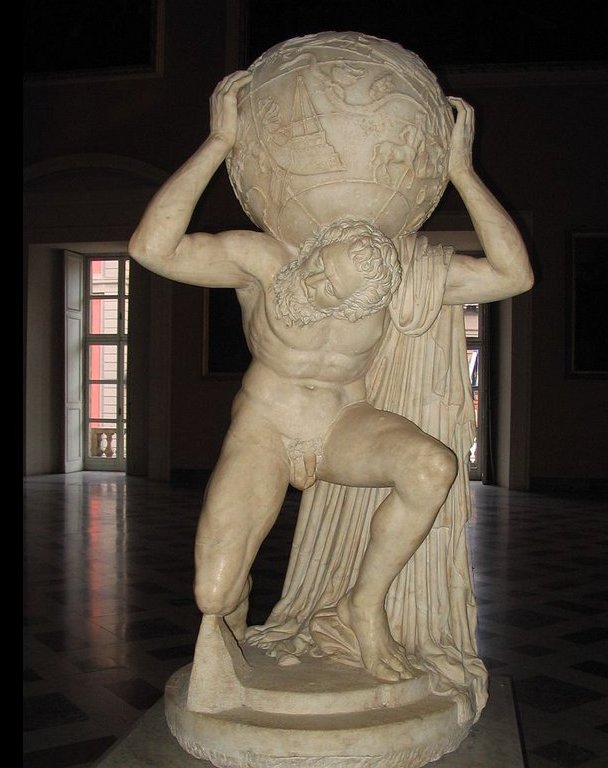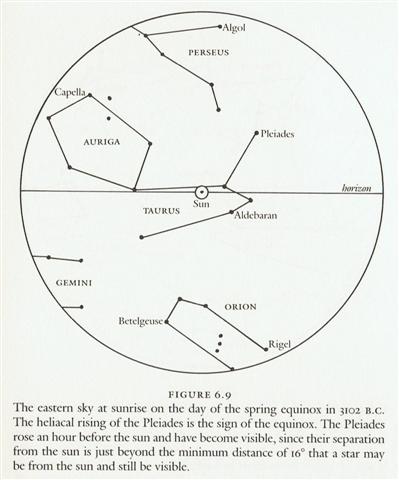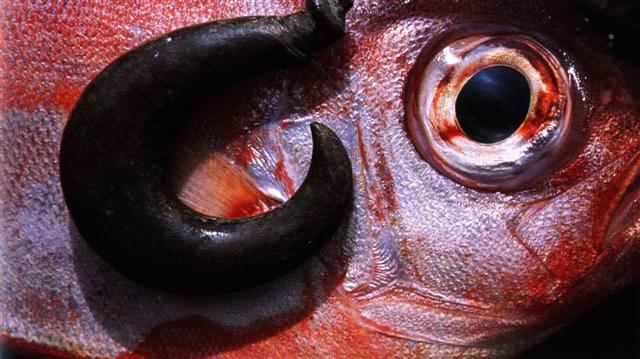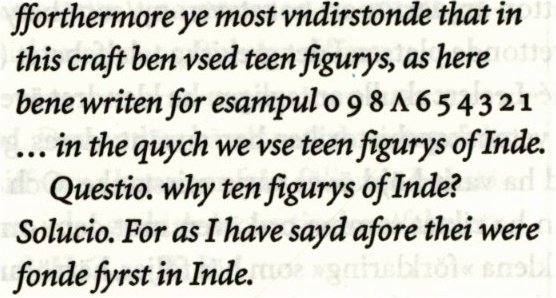Presumably the culmination (at 21h) of Atlas in December 31
served as a sign for where the
new year was due to begin:

As we can see from the celestial globe above Atlas has
his head in a strange orientation in order to show
how the facial side of the year ends at the empty Crater (Cup)
with the Raven (Corvus) at the beginning of the
other (hairy) side.

... it is told that he
[Gilgamesh] lives in splendor and dissoluteness, and
makes a nuisance of himself until the gods bring
relief to his people by rearing a human being,
either twin or counterpart,³ who can stand up to
him. It is Enkidu, the man of the Wilds, a kind of
wolf-child as simple as the beasts he plays with, a
happy son of nature, hairy all over, grown to
enormous strength ...
³ Actually, the goddess Aruru
makes him 'in the likeness of Anu', literally 'a
zikru of Anu she conceived in her heart'. But
Enkidu is also said to look like Gilgamesh 'to a
hair' ...
The stars visible in the night were at 12h which was
halfway to 24h and the precession had carried the
right ascension lines ahead with 3 months since
then, corresponding to a shift with 3h from midnight
observation to the culminations at 24h - 03h = 21h.
But anciently December carried only 29 days.
According to the epoch of Bharani the date "November 18
(i.e. *242 → number of glyphs on side b of the G
tablet) corresponded to the current date December 29 (363 =
80 + 242 +
41). The Hawaiian circuit of Lono began 10 days
later, at the last glyph on side a of the tablet (*293 =
"November 28), viz. at
the Archer (α
Sagittarii, Al-rami).
|
OCT
26 (299) |
27
(*220) |
28 |
29 |
30 |
31 |
 |
 |
 |
 |
 |
 |
|
Ga8-16 |
Ga8-17 (220) |
Ga8-18 |
Ga8-19 |
Ga8-20 |
Ga8-21 |
|
ζ
Pavonis (283.4),
λ
Cor. Austr. (283.6),
DOUBLE DOUBLE =
ε
Lyrae
(283.7),
ζ
Lyrae (283.8)
*242.0 = *283.4 - *41.4 |
South Dipper-8 (Unicorn)
Φ
Sagittarii
(284.0),
μ
Cor. Austr. (284.6),
η
Cor. Austr.,
θ
Pavonis (284.8) |
SHELIAK (Tortoise) = β Lyrae,
ν
Lyrae (285.1),
ο
Draconis (285.5).
λ
Pavonis (285.7)
ATLAS (27 Tauri) |
χ
Oct. (286.0),
AIN AL RAMI (Eye of the Archer) = ν
Sagittarii
(286.2),
υ Draconis (286.4),
δ
Lyrae (286.3),
κ
Pavonis (286.5),
ALYA (Fat Tail) = θ Serpentis
(286.6)
*245.0 = *286.4 - *41.4 |
ξ Sagittarii (287.1), ω Pavonis (287.3), ε
Aquilae, ε Cor. Austr.,
SULAPHAT (Little Tortoise Shell) = γ
Lyrae (287.4),
λ Lyrae (287.7),
ASCELLA (Armpit) = ζ Sagittarii, BERED =
i Aquilae (Ant.) (287.9)
*246.0 = *287.4 - *41.4 |
Al Na'ām-18 (Ostriches) /
Uttara Ashadha-21 (Elephant tusk, small bed)
NUNKI = σ Sagittarii (288.4), ζ Cor. Austr. (288.5),
MANUBRIUM = ο Sagittarii
(288.8), ζ Aquilae (288.9)
*247.0 = *288.4 - *41.4 |
.jpg)

... I wan't a clean cup, interrupted
the Hatter: let's all move one place
on. He moved as he spoke, and the
Dormouse followed him: the March
Hare moved into the Dormouse's
place, and Alice rather unwillingly
took the place of the March Hare.
The Hatter was the only one who got
any advantage from the change; and
Alice was a good deal worse off than
before, as the March Hare had just
upset the milk-jug into his plate
... |
|
Dec
29 (363) |
30
(*284) |
31 |
Jan 1 |
2 |
3
(368) |
|
°Dec 25 (359) |
26
(*280) |
27 |
28 |
29 |
30
(364) |
|
'Dec
2 (336) |
3
(*257) |
4 |
5 |
6 |
7
(341) |
|
"Nov 18 (312) |
19
(*243) |
20 |
21 |
22 |
23
(327) |
|
...
The correspondence between the winter
solstice and the kali'i rite of
the Makahiki is arrived at as
follows: ideally, the second ceremony of
'breaking the coconut', when the priests
assemble at the temple to spot the
rising of the Pleiades, coincides with
the full moon (Hua tapu) of the
twelfth lunar month (Welehu). In
the latter eighteenth century, the
Pleiades appear at sunset on 18
November. Ten days later (28 November),
the Lono effigy sets off on its
circuit, which lasts twenty-three days,
thus bringing the god back for the
climactic battle with the king on 21
December, the solstice (= Hawaiian 16
Makali'i). The correspondence is
'ideal' and only rarely achieved, since
it depends on the coincidence of the
full moon and the crepuscular rising of
the Pleiades
... |
|
CLOSE TO THE FULL MOON: |
|
APRIL
27 |
28 (4
* 29½) |
29 |
30
(302 - 183) |
MAY 1
(11 * 11) |
2
(*42) |
|
SIRIUS = α Canis Majoris
(101.2),
ψ5 Aurigae (101.4),
ν Gemini (101.6), ψ6 Aurigae (101.7)
*60.0 = *101.4 - *41.4 |
τ
Puppis (102.2),
ψ7 Aurigae (102.4)
*61.0 = *102.4 - *41.4 |
Mash-mashu-sha-Risū-9 (Twins of the
Shepherd)
θ
Gemini (103.0),
ψ8
Aurigae (103.2),
ALHENA =
γ
Gemini
(103.8),
ψ9
Aurigae (103.9) |
ADARA (Virgins) = ε Canis Majoris
(104.8) |
ω Gemini (105.4),
ALZIRR (Button) =
ξ
Gemini
(105.7),
MULIPHEIN (Oaths) = γ Canis Majoris
(105.8),
MEKBUDA (Contracted) = ζ Gemini
(105.9)
*64.0 = *105.4 - *41.4 |
7h (106.5)
No star listed (106) |
 |
|
June
30 |
July
1 (182) |
2 |
3
(*104) |
4 |
5
(186) |
|
°June
26 |
27 |
28 |
29
(*100) |
30 |
°July
1 (182) |
|
'June
3 |
4 |
5 |
6
(*77) |
7 |
8
(159) |
|
"May
20 |
21 |
22 |
23
(*63) |
24 |
25 (145) |
|
NOV 1 |
2
(306) |
3
(*227) |
4 |
5 |
 |
 |
 |
 |
 |
|
Ga8-22 |
Ga8-23 |
Ga8-24 (227 → π) |
Ga8-25 |
Ga8-26 |
|
19h (289.2)
λ
Aquilae (Ant.) (289.1),
γ
Cor. Austr (289.3),
τ Sagittarii (289.4),
ι
Lyrae (289.5),
δ
Cor.
Austr. (289.8)
*248.0 = *289.4 - *41.4 |
Al Baldah-19 (City)
AL BALDAH = π Sagittarii,
ALPHEKKA (Dish) MERIDIANA = α Cor.
Austr.
(290.1), β Cor. Austr. (290.2) |
ALADFAR (The Talons) = η Lyrae
(291.1),
NODUS II = δ Draconis
(291.5), ψ Sagittarii (291.6), τ
Draconis (291.7), θ Lyrae (291.8) |
ω Aquilae (292.1), ρ Sagittarii
(292.6), υ Sagittarii (292.7) |
π Draconis,
ARKAB PRIOR = β¹ Sagittarii
(293.0),
ARKAB POSTERIOR = β² Sagittarii,
ALRAMI (The Archer) = α Sagittarii
(293.2), χ Sagittarii (293.6) |
 |
|
Jan 4 |
5
(*290) |
6 |
7
(372) |
8 |
|
°Dec 31 |
°Jan 1 |
2
(*287) |
3
(368) |
4 |
|
'Dec 8 |
9 |
10 (*264) |
11 (345) |
12 |
|
"Nov 24 |
25 (329) |
26 (*250) |
27 |
28 |
|
CLOSE TO THE FULL MOON: |
|
MAY 3 (123) |
4 |
(*45 = *227 - *182) |
(*411 = *228 + *183) |
7
(492) |
|
WEZEN (Weight) = δ Canis Majoris
(107.1),
τ
Gemini (107.7),
δ
Monocerotis (107.9) |
No star listed (108) |
λ Gemini (109.4), WASAT
(Middle) = δ Gemini
(109.8)
*68.0 = *109.4 - *41.4 |
No star listed (110) |
ALUDRA (Virgin) = η Canis Majoris
(111.1),
PROPUS = ι Gemini (111.4),
GOMEISA (Water-eyed) = β Canis
Minoris
(111.6)
*70.0 = *111.4 - *41.4 |
 |
|
July 6 (*107) |
7
(188) |
8 |
9 |
10 (*111) |
|
°July 2 |
3
(184) |
4 |
5 |
6
(*107) |
|
'June 9 |
10 (161) |
11 |
12 |
13 (*84) |
|
"May 26 |
27 |
28 (148) |
29 |
30 (*70) |
 |
 |
 |
 |
 |
|
Ga2-13 |
Ga2-14 |
Ga2-15 (45) |
Ga2-16 |
Ga2-17 |
At Gb1-23
(*293 + *23 = *316) was at the solstice
according to the epoch of Bharani:
|
22 |
NOV 28 (332) |
29 |
30 (*254) |
 |
 |
 |
|
Gb1-23 |
Gb1-24 |
Gb1-25
(254) |
|
μ Aquarii (316.0) |
ε Equulei (317.8) |
No star
listed (318) |
|
Jan 31 |
Febr 1 (32) |
2 (398) |
|
°Jan 27
(392) |
28 |
29 (*314) |
|
'Jan 4 |
5 (*290) |
6 (371) |
|
SOLSTICE |
"Dec 22
(356) |
23 (*277) |
|
CLOSE TO THE FULL MOON: |
|
MAY 30 (150) |
31 |
JUNE 1
(*71) |
|
γ Pyxidis (133.6) |
ζ
Hydrae (134.1),
ρ
Cancri (134.2),
ζ
Oct.
(134.3), ο Cancri (134.6), δ
Pyxidis (134.9) |
ACUBENS
= α Cancri,
TALITHA (The First Spring of the
Gazelle) BOREALIS = ι Ursae
Majoris
(135.0), σ Cancri (135.2), ρ
Ursa Majoris (135.6) |
 |
|
Aug 1 |
2 (214) |
3 (*500) |
|
°July 28 |
29 (210) |
30 (*131) |
|
'July 5 (186) |
6 |
7 (*108) |
|
SOLSTICE |
"June 22
(*93) |
23 |
 |
 |
 |
|
Ga3-10 |
Ga3-11 |
Ga3-12 (71) |
|
... Once upon a time
there was an old woman who owned a great
potato field where she planted her potatoes
in spring and harvested them in autumn. She
was famous all around for her many varieties
of wonderful potatoes, and she had enough of
them to sell at the market place. She
planted her potatoes 7 in a row, placing her
foot in front of her as a measure from one
potato to the next. Then she marked the
place with a bean - which would also give
nourishment to the surrounding potatoes.
Next she changed variety and planted 7 more
followed by another bean, and this was the
pattern she followed until all her 214
varieties had been put down in their proper
places. She had drawn a map which she
followed and from where each sort of potato
could be located at the proper time for its
harvest. I was fascinated, when I happened
to stumble on this Swedish TV program,
because my 'once upon a time' was now and
214 (= 2 * 107) was surely no coincidence.
She knew what she was doing. Let's therefore
count: 214 * 7 (potatoes) + 213 (beans) =
1711. So what? Probably because 1711 = 59 *
29
... And 59 + 29 = 88. |
|
472 = 365 + 107 |
|
297 |
 |
13 |
 |
23 |
 |
 |
115 |
 |
18 |
 |
|
Gb1-24 (253) |
Gb2-12 (267) |
Gb3-1 |
Gb3-2 |
Gb6-26 (408) |
Gb7-17 (427) |
|
Febr 1 (32) |
15 (46) |
11 (435) |
March 12 |
March 21 (445) |
April 9 (99) |
|
ε Equulei (*317) |
WEEPING |
*354 |
*355 |
|
SIRRAH |
ADHIL (*19) |
|
ACUBENS (*135) |
*149 |
*171 |
*172 |
8 |
ALCHITA (*183) |
SPICA (*202) |
|
Aug 3 (580) |
17 (229) |
|
|
Sept 20 (263) |
Oct 9 (282) |
|
"Dec 22 (356) |
"Jan 5 (370) |
*313 |
*314 |
"Febr 8 (39) |
27 (58) |
|
"June 22 (173) |
"July 6 (*107) |
*130 |
*131 |
|
"Aug 10 (*142) |
"Aug 29 (*161) |
|
336 (= 4 * 84 = 7 * 48 = 12 *
28) |
29 |
|
365 |
On the other hand there is also evidence of
a year beginning when the Bright Fire was at
the Full Moon. This can be explained by
counting: λ Cancri (*125.4) - λ Gemini
(*109.4) = *16 (= 100 - 84 = 366 - 350):
... we should reduce with 16 days because
anciently they waited for the return to
visibility of the relevant star ...

... the 'Gate of Cancer'
means Gemini ...
|
he ruru
- he taiko |
181 |
|
... Actually, the goddess Aruru
makes him 'in the likeness of Anu', literally 'a
zikru of Anu she conceived in her heart'. But
Enkidu is also said to look like Gilgamesh 'to a
hair' ...
... Sula cyanops ... It
should be pointed out that the
combined name ruru-taiko
refers in MAO. to a black petrel (Procellaria
parkinsoni). There are no
cultural data available for ruru,
which seems to be derived from PPN.
*lulu 'owl'...

|
 |
 |
|
Ab4-12 |
Ba5-42 |
|
|
MAY 20 (280 / 2) |
21 (141) |
 |
 |
|
Ga3-1 |
Ga3-2 (61) |
|
AL TARF (The End) = β Cancri
(124.3)
RAS ALGETHI (α Herculis) |
χ
Cancri (125.2),
BRIGHT FIRE = λ Cancri (125.4)
*84.0 = *125.4 - *41.4 |
 |
|
July 23 (408 / 2) |
24 (205) |
|
... The month, which takes its name
from Juppiter the oak-god, begins on
June 10th and ends of July 7th.
Midway comes St. John's Day, June
24th, the day on which the oak-king
was sacrificially burned alive. The
Celtic year was divided into two
halves with the second half
beginning in July, apparently after
a seven-day wake, or funeral feast,
in the oak-king's honour ... |
|
°July 19 (400 / 2) |
20 (201) |
|
'June 26 (354
/ 2) |
27 (178) |
|
"June 12 (326 / 2) |
13 (164) |
|
CLOSE TO THE FULL MOON: |
|
NOV 19 (*243) |
20 (324 = 141 + 183) |
|
GREDI (Goat) = α Capricorni
(307.2),
σ
Capricorni (307.5),
ALSHAT (The Sheep) = ν Capricorni
(307.9) |
Al Sa’d al Dhabih-20 (Lucky One of
the Slaughterers) /
Ox / Herd Boy-9
(Buffalo)
DABIH = β Capricorni
(308.0),
κ
Sagittarii (308.1),
SADIR (Hen's Breast) = γ Cygni
(308.4),
PEACOCK = α Pavonis
(308.7)
*267.0 = *308.4 - *41.4 |
|
Jan 22 (387 = 204 + 183) |
23 |
|
°Jan 18 (384) |
19 |
|
'Dec 26 (360) |
27 |
|
"Dec 12 (346 = 163 + 183) |
LUCIA |
 |
|
NOV 19 |
20 (324) |
21 |
22 (141 + 185) |
23 |
24 (*248) |
 |
 |
 |
 |
 |
 |
|
Gb1-14 (9 * 27) |
Gb1-15 (244) |
Gb1-16 |
Gb1-17 (61 + 185) |
Gb1-18 |
Gb1-19 (248) |
 |
205 |
 |
|
Ga2-11 (41) |
Gb1-18 (247 = 41 +
183 + 23) |
|
ºJune 30 (181) -
heliacal Sirius |
182 |
'Dec 30 (364) -
nakshatra Sirius |
|
ºDec 30 (364 = 181 +
183) |
'June 30 (181 = 364
- 183) |
|
23 = precessional
depth from the time
of Gregory XIII down
to Roman times |
|
... Thus was dry
land fished up by
Maui, which had lain
beneath the sea ever
since the great
rains that were sent
by the Sky father
and the god of
winds. The Maori
people say that the
north island of
Aotearoa, which
certainly is shaped
much like a fish, is
Te Ika a Maui;
and according to
some tribes the
south island is the
canoe from which he
caught it. And his
hook is the cape at
Heretaunga
once known as Te
matau a Maui,
Maui's Fishhook
(Cape Kidnappers).
In some of the other
islands which lie
across the sea
towards Hawaiki,
the people say that
theirs is the land
that Maui pulled up
from below
...
 |
|
|
GREDI (Goat) = α Capricorni
(307.2),
σ
Capricorni (307.5),
ALSHAT (The Sheep) = ν
Capricorni
(307.9) |
Al Sa’d al Dhabih-20 (Lucky One
of the Slaughterers) /
Ox / Herd Boy-9
(Buffalo)
DABIH = β Capricorni
(308.0),
κ
Sagittarii (308.1),
SADIR (Hen's Breast) = γ Cygni
(308.4),
PEACOCK = α Pavonis
(308.7)
*267.0 = *308.4 - *41.4 |
OKUL = π Capricorni
(309.6),
BOS =
ρ
Capricorni
(309.9)
ARNEB (α Leporis)
MINTAKA (δ Orionis) |
ο
Capricorni (310.2),
θ
Cephei (310.5)
HEKA (λ
Orionis)
ALNILAM (ε Orionis) |
ROTTEN MELON = ε Delphini,
φ
Pavonis (311.2),
η
Delphini (311.4),
ζ
Delphini,
ρ
Pavonis (311.7)
PHAKT (α
Columbae)
ALNILAK (ζ
Orionis) |
ROTANEV = β Delphini,
ι Delphini (312.3), τ Capricorni
(312.6), κ Delphini (312.7),
SVALOCIN = α Delphini,
υ Capricorni, υ Pavonis (312.8) |
|
KHUFU |
KHAFRE |
MENKAURE
|
.jpg) |
|
Jan 22 |
23 (*308) |
24 |
25 |
26 |
27 (392) |
|
°Jan 18 |
19 (*304) |
20 |
21 |
22 |
23 (388) |
|
'Dec 26 |
27 |
28 |
29 |
30 (364) |
31 (*285) |
|
"Dec 12 |
13 |
14 (348) |
15 |
16 (350) |
17 (*271) |
|
CLOSE TO THE FULL MOON: |
|
MAY 20 |
21 |
22 |
23 (*63) |
24 (144) |
25 (290 /
2) |
|
AL TARF (The End) = β Cancri
(124.3)
RAS ALGETHI (α Herculis) |
χ
Cancri (125.2),
BRIGHT FIRE = λ Cancri (125.4)
*84.0 = *125.4 - *41.4 |
AVIOR = ε Carinae (126.4),
φ
Cancri (126.8)
*85.0 = *126.4 - *41.4 |
ο Ursae Majoris (127.4)
*86.0 = *127.4 - *41.4 |
Pushya-8 (Nourisher)
υ Cancri (128.1), θ Cancri
(128.2) |
Āshleshā-9 (Embrace) /
Willow-24 (Stag)
π¹ Ursa Majoris,
δ HYDRAE (129.6),
AL MINHAR AL
SHUJĀ = σ Hydrae,
MUSEIDA = π² Ursae
Majoris
(129.9)
RAS ALHAGUE (α Ophiuchi) |
 |
|
July 23 (204) |
24 |
25 |
26 (*127) |
27 |
28 |
|
°July 19 (200) |
20 |
21 |
22 (*123) |
23 |
24 |
|
'June 26 (177) |
27 |
28 |
29 (*100) |
SIRIUS (181) |
'July 1 |
|
"June 12 |
13 |
14 |
15 (*86) |
16 |
17 (168) |
 |
 |
 |
 |
 |
 |
|
Ga3-1 |
Ga3-2 (61) |
Ga3-3 |
Ga3-4 |
Ga3-5 |
Ga3-6 |
|
he ruru
- he taiko |
he kumara - he kiakia |
he tuvi -
he tuao |
|
... The
transference of the name for
sweet potatoes, kumara,
to a sea bird (Oestrelata
incerta or Oestrelata
leucoptera) presents a
problem in taxonomy. In a short
recitation that accompanies the
string game, the next bird on
the list, kiakia, the
white tern, is associated with
the leaves of the sweet potato
... White tern.
Leucanus albus royanus ...
... Grey tern, Tuvituvi (Procelsterna
caerulea skottsbergi)
...
Anous stolidus unicolor
... The dark brown tern with a
round tail is called tuao
... I was told that tavi
is a small, lead-colored bird
that lives on the little islets
(motu) off the coast. He
is supposed to look like the
tuvi, the grey tern, and
owes his name to his call
... |
... Men's spirits
were thought to dwell in the Milky Way
between incarnations. This conception
has been handed down as an Orphic and
Pythagorean tradition fitting into the
frame of the migration of the soul.
Macrobius, who has provided the broadest
report on the matter, has it that souls
ascend by way of Capricorn, and then, in
order to be reborn, descend again
through the 'Gate of Cancer'. Macrobius
talks of signs; the
constellations rising at the solstices
in his time (and still in ours) were
Gemini and Sagittarius: the 'Gate of
Cancer' means Gemini. In fact, he states
explicitly (I,12.5) that this 'Gate' is
'where the Zodiac and the Milky Way
intersect'. Far away, the Mangaians of
old (Austral Islands, Polynesia), who
kept the precessional clock running
instead of switching over to 'signs',
claim that only at the evening of the
solstitial days can spirits enter
heaven, the inhabitants of the northern
parts of the island at one solstice, the
dwellers in the south at the other
... Considering the fact that the
crossroads of ecliptic and Galaxy are
crisis-resistant, that is, not concerned
with the Precession, the reader may want
to know why the Mangaians thought they
could go to heaven only on the two
solstitial days. Because, in order to
'change trains' comfortably, the
constellations that serve as 'gates' to
the Milky Way must 'stand' upon the
'earth', meaning that they must rise
heliacally either at the equinoxes or at
the solstices. The Galaxy is a very
broad highway, but even so there must
have been some bitter millenia when
neither gate was directly available any
longer, the one hanging in midair, the
other having turned into a submarine
entrance ...
The right knee of Atlas (in the
illustration above) is resting upon the
likeness of (zikru) a pyramid (ziggurath) -
i.e. similar to the figure (zikru)
of the Greek letter lambda (Λ).



|






.jpg)






















.jpg)




